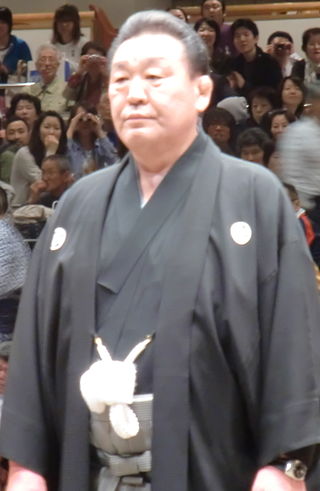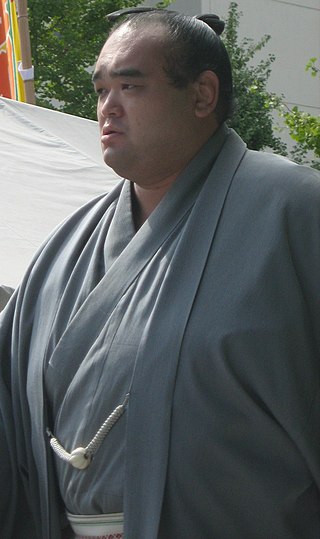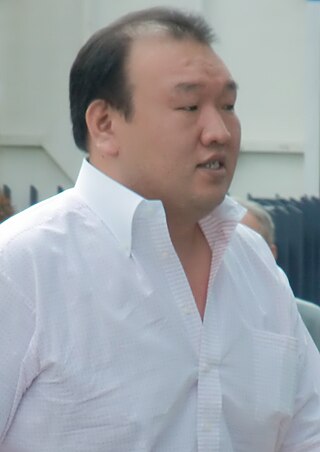Related Research Articles

Mienoumi Tsuyoshi is a Japanese former professional sumo wrestler from Matsusaka, Mie. He was the 57th yokozuna of the sport. After retiring he founded the Musashigawa stable and was a chairman of the Japan Sumo Association. He was the first rikishi in history who was demoted from the rank of Ozeki but still managed the promotion to Yokozuna.

Sadanoyama Shinmatsu was a Japanese professional sumo wrestler from Nagasaki Prefecture. He was the sport's 50th yokozuna. After his retirement he was the head coach of Dewanoumi stable and served as head of the Japan Sumo Association.

Tokitsuumi Masahiro is a former professional sumo wrestler from Fukue, Nagasaki, Japan. A former amateur sumo champion, he turned professional in 1996. His highest rank was maegashira 3. He became the head coach of Tokitsukaze stable in 2007 following the dismissal of the previous stablemaster. He was asked to retire by the Japan Sumo Association in February 2021 for violating COVID-19 safety protocols.

Wakashimazu Mutsuo is a Japanese former sumo wrestler from Nakatane, Kagoshima, Japan. His highest rank was ōzeki. He won two top division yūshō or tournament championships. He retired in 1987 and founded Matsugane stable in 1990.

Hamanishiki Tatsurō is a former sumo wrestler from Kumamoto, Japan. A former amateur champion, he made his professional debut in 1999. His highest rank was maegashira 11, which he reached in 2002. He was mostly ranked in the makushita and sandanme divisions from 2005 until his retirement in 2012. He became an elder of the Japan Sumo Association upon his retirement and was the head coach of the Kasugayama stable from 2012 until 2016.
Kōbō Kenichi was a Japanese sumo wrestler. His highest rank was maegashira 9.
Masuiyama Daishirō is a former sumo wrestler and coach from Hyōgo, Japan. In 1980 he became the oldest wrestler to be promoted to the rank of ōzeki in the modern era. After retiring from active competition in 1981 he became a sumo coach and an elder of the Japan Sumo Association under the name Mihogaseki and produced several top division wrestlers as head of Mihogaseki stable before stepping down upon reaching age 65 in 2013. He is also an enka musician.

Asahiyutaka Katsuteru is a former sumo wrestler from Kasugai, Aichi, Japan. His highest rank was komusubi. He is now the head coach of Tatsunami stable.

Bushūyama Takashi is a Japanese former sumo wrestler from Aomori, Aomori Prefecture. He made his professional debut in January 1999. At the age of 32, he was promoted to the top makuuchi division in the November 2008 tournament. His highest rank was maegashira 3. He is now a sumo coach.

Aobajō Yukio is a Japanese former professional sumo wrestler from Sendai, Miyagi Prefecture. He did not miss a single bout in his 22-year professional career, and holds the record for the most consecutive matches fought, at 1,630. After his retirement from active competition he was an elder of the Japan Sumo Association and a coach.

Kasugafuji Akihiro, born as Shoki Iwanaga, was a Japanese sumo wrestler and coach from Oshika, Miyagi. He was an active wrestler in professional sumo from 1981 until 1996, reaching a highest rank of maegashira 1. After his retirement he re-established the Kasugayama stable in 1997 and trained his own wrestlers. He left the Japan Sumo Association in 2012 after an expenses scandal, and was involved with a legal dispute in 2013 with his successor as head of Kasugayama stable which was not resolved until shortly before his death in 2017.

Kotoinazuma Yoshihiro is a former sumo wrestler from Niiharu, Gunma, Japan. He made his professional debut in 1978, and reached the top division in 1987. His highest rank was komusubi and he earned two special prizes. After retirement he became an elder in the Japan Sumo Association and as of 2016 he is a coach at Sadogatake stable under the name Kumegawa.
Kitakachidoki Hayato is a former sumo wrestler from Obihiro, Hokkaidō, Japan. He made his professional debut in 1981, and reached the top division in 1989. His highest rank was maegashira 3. After retirement he became an elder in the Japan Sumo Association. He took over as head coach at Isenoumi stable, when former head coach Fujinokawa reached mandatory retirement age in September 2011.

Daitetsu Tadamitsu is a former sumo wrestler from Ōno, Fukui, Japan. He made his professional debut in July 1971, and reached the top division in November, 1983. His highest rank was komusubi. He retired in September 1990, and has worked as a coach at both the original Nishonoseki stable and the new version of the stable, under the elder name Minatogawa.

Ganyū Kenji is a former sumo wrestler from Himeji, Hyōgo, Japan. He made his professional debut in March 1986, and reached the top division in March 1996. His highest rank was maegashira 1. He retired in 2000 and became an elder of the Japan Sumo Association. In 2015 he became the head coach of Yamahibiki stable following the death of his old stablemaster, Kitanoumi.
Fujinoshin Tsukasa is a former sumo wrestler from Funabashi, Chiba, Japan. He made his professional debut in March 1976, and reached the top division in September 1986. His highest rank was maegashira 1. He retired in September 1990 after injury problems and became an elder in the Japan Sumo Association.

Shikishima Katsumori is a former sumo wrestler from Funabashi, Chiba, Japan. He made his professional debut in January 1989, and reached the top division in November 1994. His highest rank was maegashira 1. He defeated Takanohana twice in 1998 to earn his only two kinboshi for a yokozuna upset. His stablemaster, former sekiwake Aonosato retired in November 2000 and he moved from Tatsutagawa stable to Michinoku stable. He retired in May 2001 after being diagnosed with a heart ailment, and has remained in sumo as an elder of the Japan Sumo Association and coach at Michinoku. He has borrowed a succession of elder names since his retirement. Since 2013 he has been known as Urakaze.
Asahisato Kenji is a former sumo wrestler from Ikeda, Osaka, Japan. His active career spanned 17 years and 102 tournaments from 1981 until 1998, and his highest rank was maegashira 14. Upon his retirement he became an elder of the Japan Sumo Association. He took charge of Nakagawa stable in January 2017, but the stable was closed in July 2020 and he was demoted two rungs in the Sumo Association's hierarchy after he was found to have mistreated wrestlers in the stable.
Shinji Hamada, better known as Toyonoumi Shinji, was a Japanese sumo wrestler from Buzen, Fukuoka. He made his professional debut in March 1981 and reached the top division in November 1988. He was known by the shikona Takanohama until 1990. His highest rank was maegashira 1. He did not miss a single bout in his 19-year professional career. Upon retirement from active competition he became an elder in the Japan Sumo Association, under the name Yamahibiki. He left the Sumo Association in June 2002.
References
- 1 2 "Oyama retires before turning 70 years old". Nikkan Sports (in Japanese). 2 September 2022. Retrieved 2 September 2022.
- ↑ "Oyakata (Coaches)". Nihon Sumo Kyokai. Retrieved 17 August 2016.
- ↑ "Daihi Susumu Kabu History". Sumo Reference. Retrieved 1 October 2012.
- ↑ "Daihi Susumu Rikishi Information". Sumo Reference. Retrieved 2 September 2012.